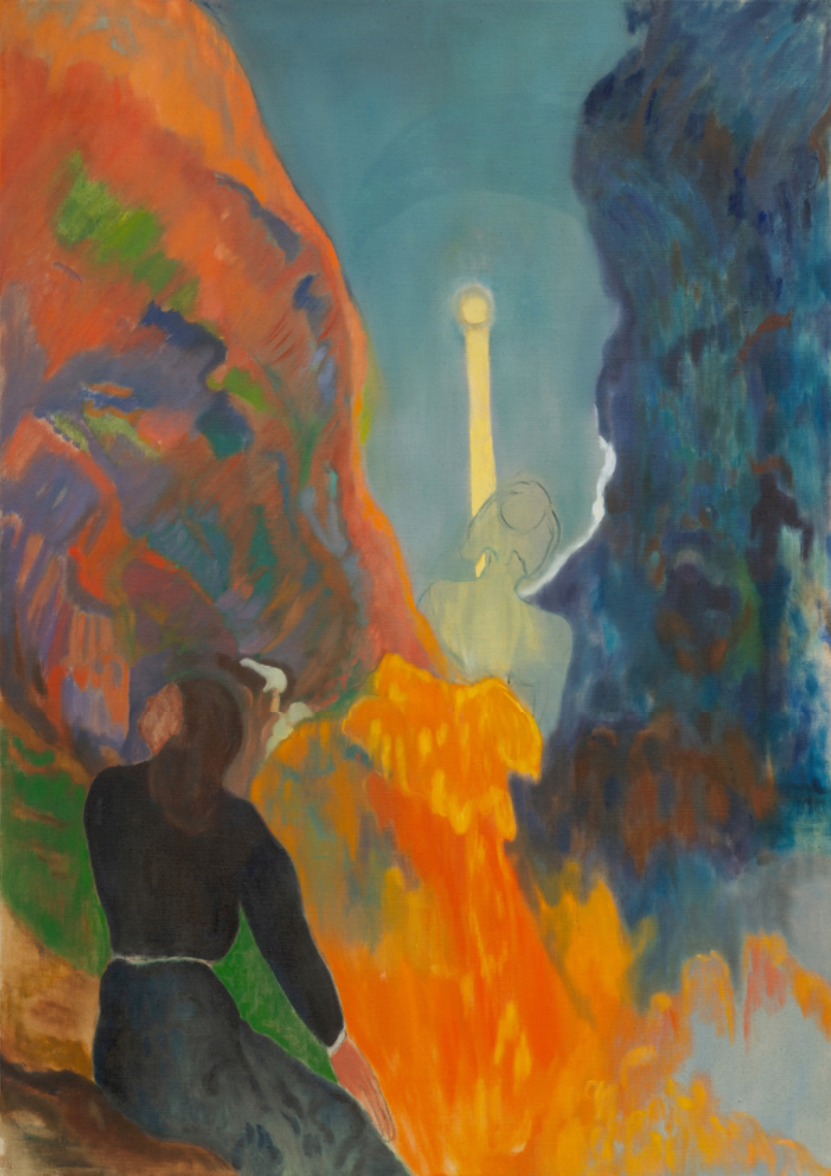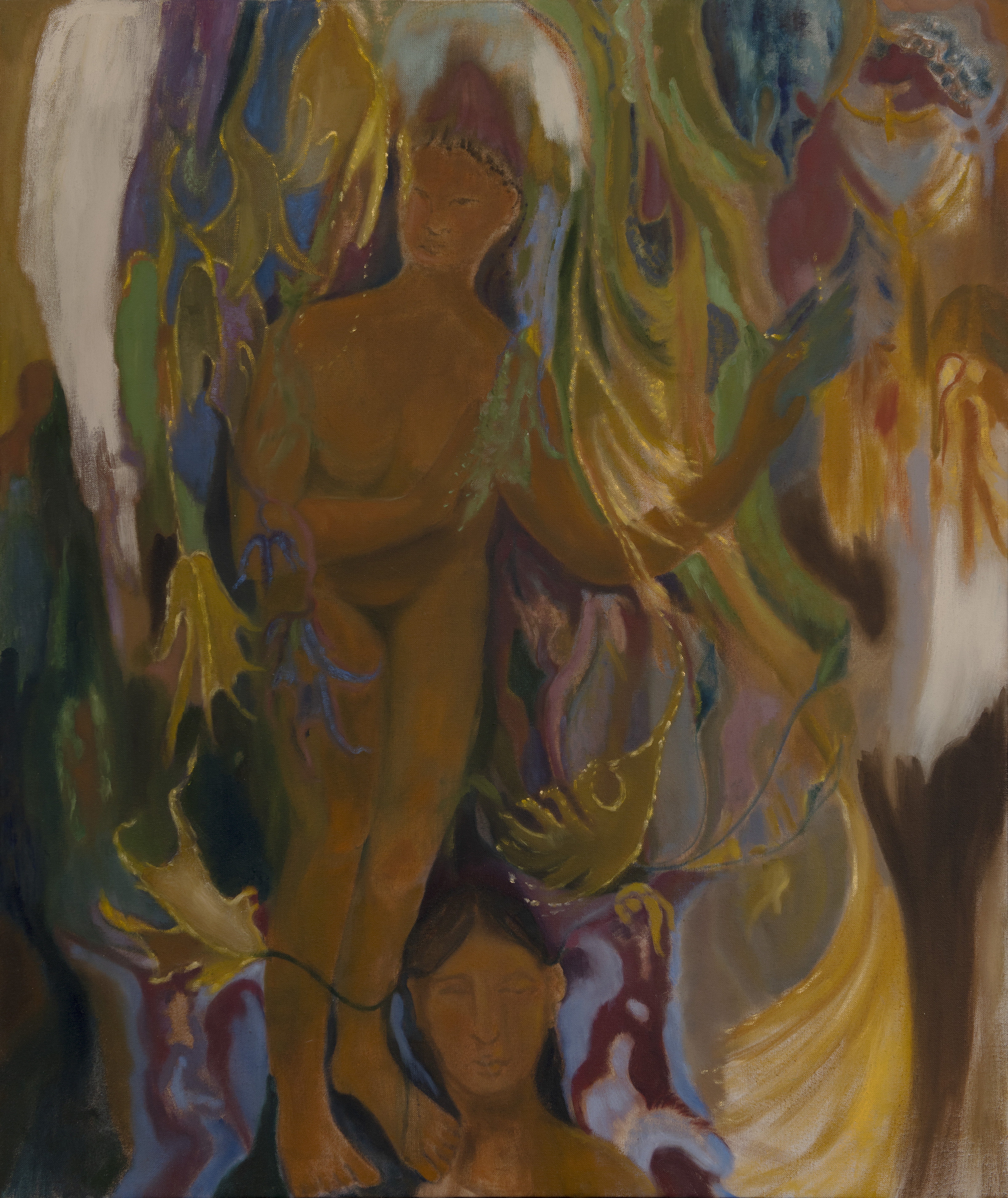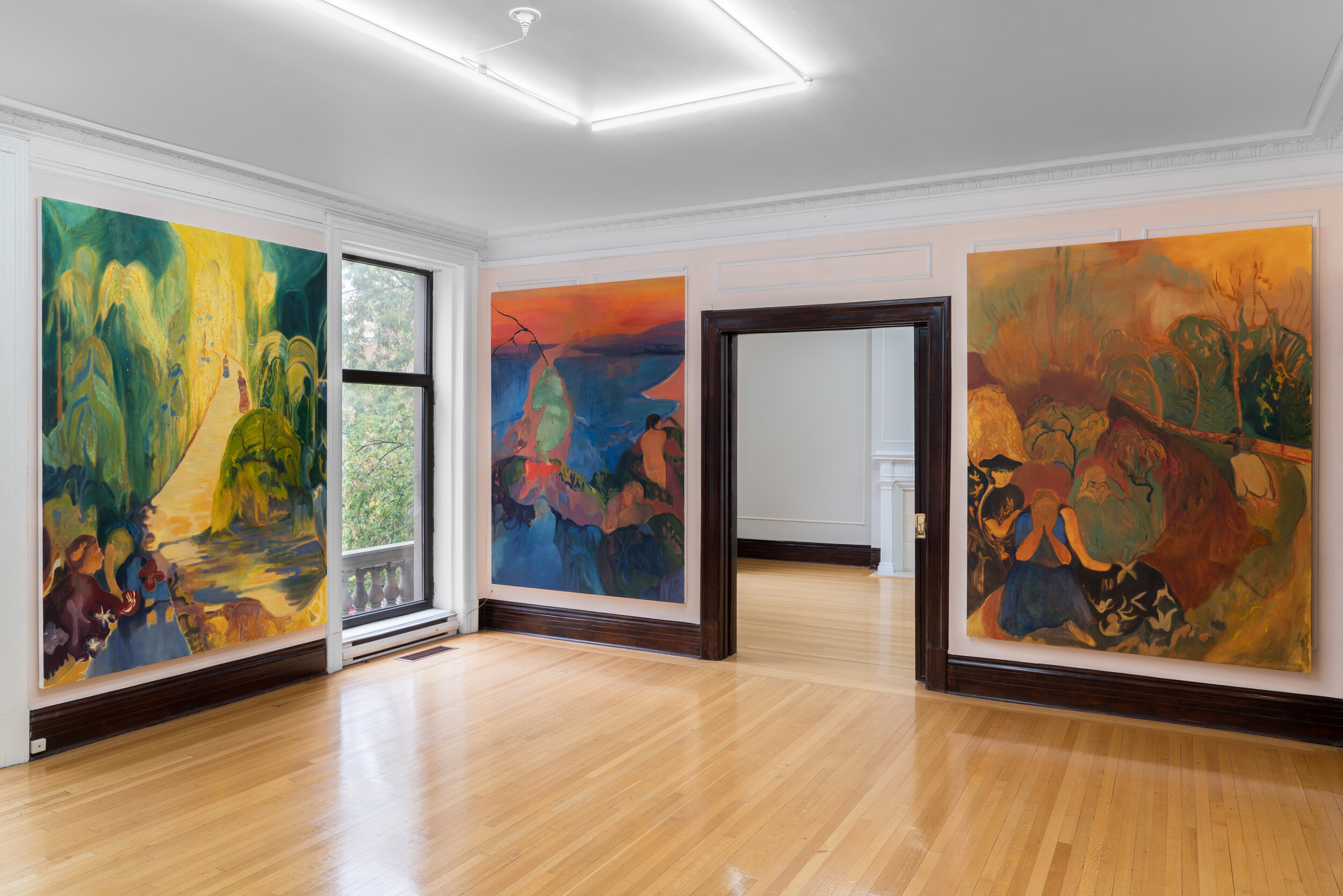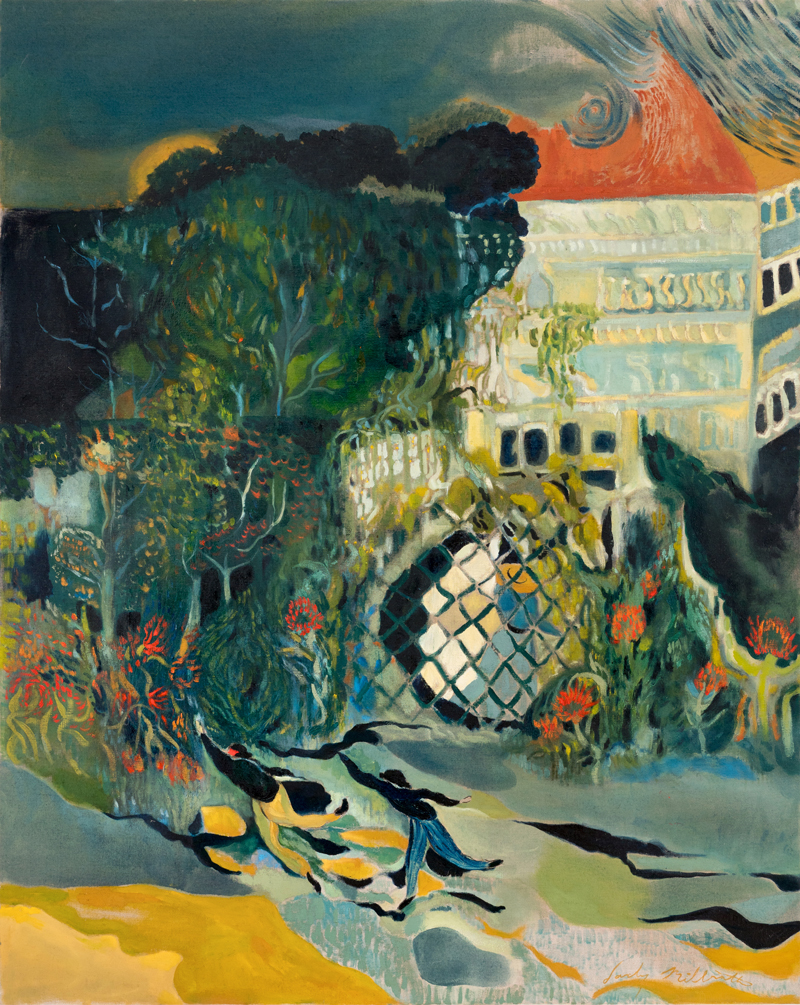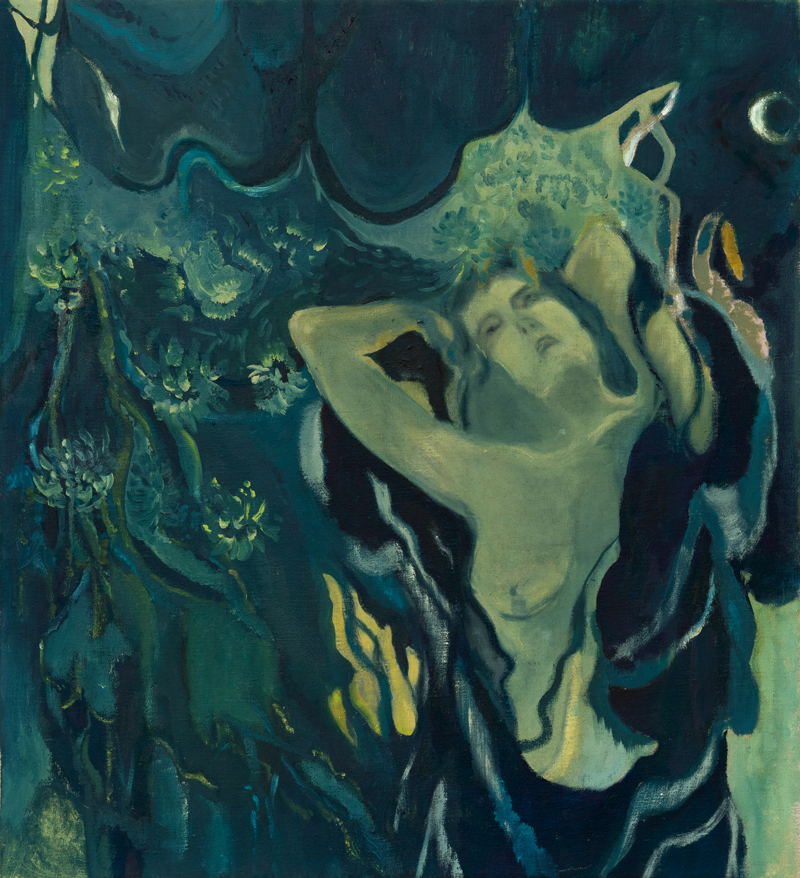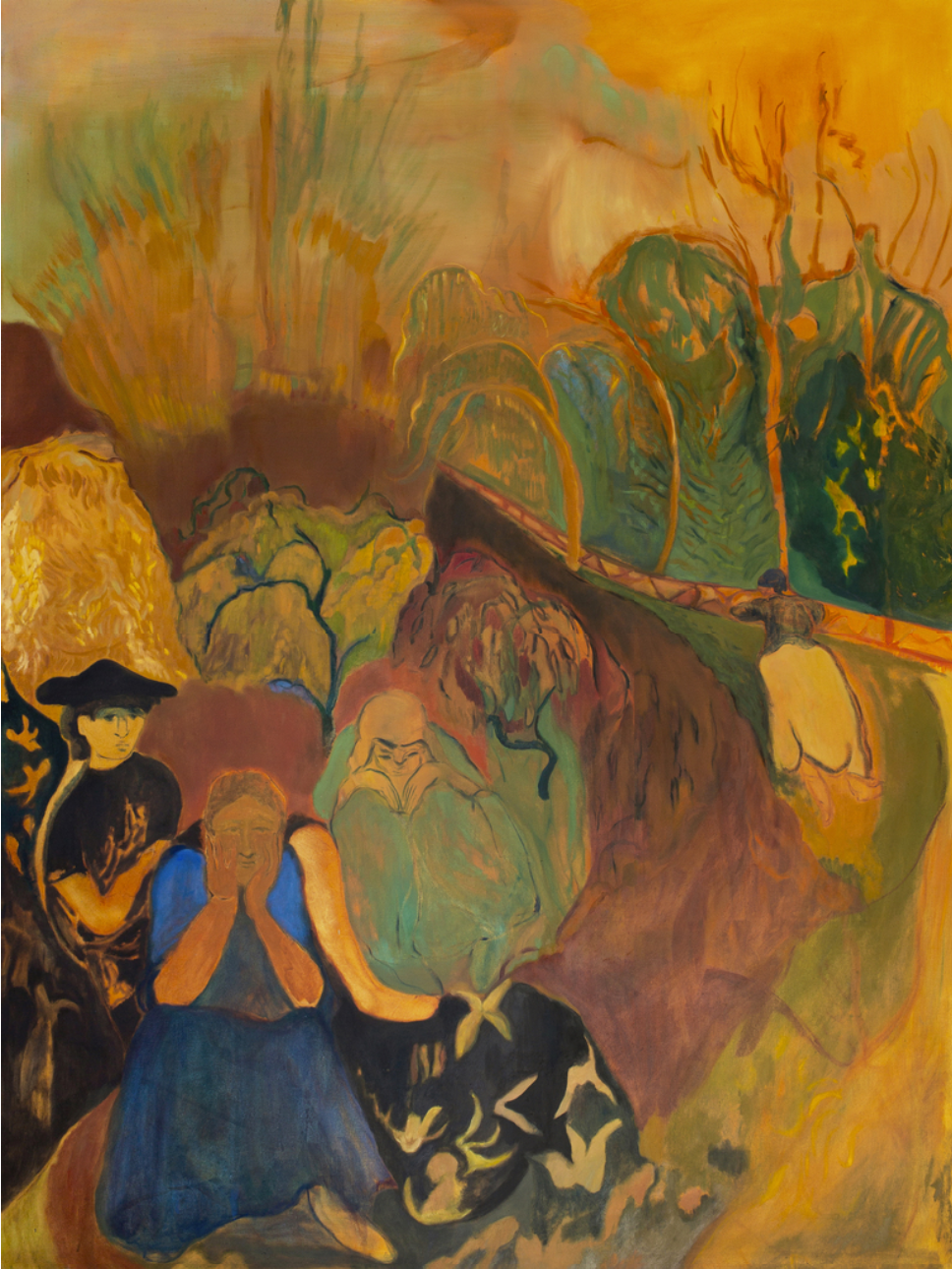For Toronto-based Darby Milbrath, the canvas is the site of evocation for the mystical and emotive natural realm. Symbols and figures mingle with rich foliage in compositions that allude to the self-taught painter’s memories and personal dreamscapes as well as her background in dance and herbalism.
We spoke to Milbrath about the origins of her atmospheric paintings, her painterly intuition, and the holistic approach to her practice.
![]()
Above the Sea, 2020,
oil on linen, 62 x 44 inches
What was the first thing you thought about when you woke up this morning?
I'm very focused on my upcoming exhibition [08] in London, which is opening April 8th at PM/AM gallery. This is the final week before my paintings leave the studio, so I woke up thinking of all the preparations needed for shipment. Normally, I have more of a relaxing morning, but I’m still adjusting to the increase in demand for my work and learning how to manage how much I've taken on.
Can you tell us about this upcoming show?
My work comes intuitively. Ideas emerge through the act of painting instead of conceptually. For this show though, I did a lot of writing and research before production. I see it like filling a well and then drawing from that. I have a background in herbalism so my research was a continuation of my plant studies focusing primarily on hallucinogenic plants and animals like the Fish of Dreams, Psilocybin mushrooms, Devil’s Trumpets, Deadly Nightshade, Dwale and other historical potions.
I was also reading a lot on Romanticism and William Blake and researching other artists and poets who placed an emphasis on emotion, mysticism, and the sublimity of nature. I'm really inspired by Blake’s Songs of Innocence and Experience. I’m drawn particularly to his poems about children becoming lost and found as a metaphor for the innocence of childhood and the blissful state of it, and then the often sorrowful and existential state of being an adult. There are a few paintings in the exhibition of solitaire figures who are lost or hiding, whether literally, within a wild landscape, or figuratively, in a state of dreams or hallucinations. Mushrooms, flying fish and other glowing flowers are sprinkled into this new work too. There’s a lot of darkness in the show. The paintings are literally quite dark in colour but the subject matter is as well.
I was also reading a lot on Romanticism and William Blake and researching other artists and poets who placed an emphasis on emotion, mysticism, and the sublimity of nature. I'm really inspired by Blake’s Songs of Innocence and Experience. I’m drawn particularly to his poems about children becoming lost and found as a metaphor for the innocence of childhood and the blissful state of it, and then the often sorrowful and existential state of being an adult. There are a few paintings in the exhibition of solitaire figures who are lost or hiding, whether literally, within a wild landscape, or figuratively, in a state of dreams or hallucinations. Mushrooms, flying fish and other glowing flowers are sprinkled into this new work too. There’s a lot of darkness in the show. The paintings are literally quite dark in colour but the subject matter is as well.
![]()
Once a Dream Did Weave a Shade, 2021
oil on linen, 48 x 40 inches

Once a Dream Did Weave a Shade, 2021
oil on linen, 48 x 40 inches
Is there an emphasis on experience over narrative or maybe the other way around?
My paintings have always been like diary entries in that they intimately express how I'm feeling or what I am experiencing in a symbolic way. I don’t actively create narratives in my paintings, they just come out that way. And sometimes throughout my process of painting over paintings multiple times, a canvas will evolve in these layers of stories that I get to watch unfold.
You have a background in perfumery as well. Do you see these interests as separate practices or do they inform each other?
I definitely think they all harmonize together. Everything that I've ever experienced or learned goes into my painting. Perfumery and herbalism have a similar alchemy as painting does, in that you are mixing colors together to make a new thing. That sort of energy and magic has a power in it. I do feel that while I’m preparing herbal tinctures and teas, making perfume blends, or even arranging flowers, I am composing in a similar way as painting. I have a background in dance, which also comes into the work in so many ways; it all kind of feels like choreography.
Right, you were a professional contemporary dancer. What did the transition from dancing to teaching yourself how to paint look like for you? What was the impetus of the switch?
Dance has been such a rich medium for me to draw from. It’s informed how I paint. Movement, musicality and theatrical elements like light, costume, and theater set drops have influenced my painting a lot. Even the magic and superstition of the theater enters my work. There is a sisterhood and sense of ritual that happens between dancers, particularly in the theatre before performance.
I ended up leaving dance professionally largely due to injuries. I’m not sure it was the right medium for me. I really appreciated the immediacy of paint as an expression, something that anyone can do in solitude in a small space. It was such an escape for me, and felt very therapeutic after years of working in a medium where there is an emphasis on athleticism, body image, performance, extraversion and working with others. I still dance regularly and use it to support my painting practise. I find dancing helps me to get into my body and into the present moment, which helps me to paint more freely.
I ended up leaving dance professionally largely due to injuries. I’m not sure it was the right medium for me. I really appreciated the immediacy of paint as an expression, something that anyone can do in solitude in a small space. It was such an escape for me, and felt very therapeutic after years of working in a medium where there is an emphasis on athleticism, body image, performance, extraversion and working with others. I still dance regularly and use it to support my painting practise. I find dancing helps me to get into my body and into the present moment, which helps me to paint more freely.
![]()
Washing the Bedding, 2018,
oil on linen, 56 x 42 inches
What is the first thing that you remember creating and thinking, “this is art?”
I love that. My sisters, my brother, and I did a lot of drawing and painting when we were little, and my parents were really encouraging. When we were younger the kitchen walls and even the ceiling were completely covered with our artworks. I've also always kept a diary. I remember feeling the importance of my diary and how I would keep it locked, like it was a sacred art object.
So you're a self taught painter. What are some lessons that you've had to teach yourself along the way?
So many lessons, I am continually learning. I feel like my learning will be lifelong, and I think that's why painting is so stimulating to me, because it's just always changing. I don’t work in a formulaic way; I'll go to do a painting and it's a completely different experience than the last one. I’m learning about colour, experimenting with different limited palettes, and learning about complimentary colours. I'm experimenting with different grays, and all the beautiful ways you can push a color to its limit with a very limited palette, and how a pure color will really pop against these gray tones. I'm learning a lot about trickery, and how to create illusion, how to make something look like it's floating with the use of shadow and light. Even just on a very basic level, when I started painting with oils, I didn't know about painting mediums, colour theory, how to prepare a canvas, how to be safe in the studio.Everything I know I learned through trial and error.
![]()
Descent into Paradise, 2021,
oil in linen, 48 x 40 inches
The works in your show at Projet Pangee [Although the Wind] seem like your largest paintings to date. I could be wrong, but they are enormous. Do you feel like that's the right scale for you to create on, especially given that you're working with the body and intuition?
Yes, they were the largest scale works I've ever created. It was thrilling, and also very challenging. I did feel very physical with that work. It felt closer to dancing, using large gestures and huge brushes but working as quickly as I would on a smaller scale. To get that level of energy and movement was a challenge, especially as it was the beginning of the pandemic when I was finding it harder to access my power and confidence. I very stubbornly decided I would paint four massive canvases at once, and as they would not fit up the stairs to my tiny studio at the time, I had to haul them up over the side of a four story building on a busy street.
![]()
The Fool, 2020,
oil on canvas, 96 x 72 inches

The Fool, 2020,
oil on canvas, 96 x 72 inches
“I did feel very physical with that work. It felt closer to dancing, using large gestures and huge brushes, but working as quickly as I would on a smaller scale.”
It almost felt like a form of flagellation in a way. I thought that if I could succeed in creating four of the largest canvases I’d ever made, in such a tiny space, in a very uncertain time, that I could do anything.I do feel more comfortable working smaller, just because they're very intimate and manageable, and I can paint them outside of the studio. I think that comfort comes from experience; the more I'm working on these larger scale works, the more ease I think will come.
When you're a self taught artist, most people want to see a certain level of commitment before they invest in you. I think making these ambitious, larger scale paintings, especially as a woman, helped with that, and fortunately many opportunities became of that exhibition.
When you're a self taught artist, most people want to see a certain level of commitment before they invest in you. I think making these ambitious, larger scale paintings, especially as a woman, helped with that, and fortunately many opportunities became of that exhibition.
![]()
Installation view, Although the Wind, 2020,
Projet Pangée, Montreal
What do you have in mind when you approach the canvas? An emotion, a color, form?
Generally, I will begin a painting with some impulse or idea. It’s helpful when confronted by a blank canvas. Sometimes I've started a painting inspired by simple things, like looking at a peeled orange or a single flower, or I'll think of a memory of a place, a landscape, where I spent time in, or a dream that I had. Sometimes I'm looking at art history, a Chagall painting for example, and I’ll be inspired by the one color used in a certain area. Colour and music has always been my leading inspiration.
I find very quickly, once paint is on the canvas, that it becomes its own entity, and it does what it wants; my original “idea” will be obliterated many times, and it is out of that mess that I can begin seeing some glimmer of what the painting might be. When starting a new painting I have to remain open, almost in a passive form of listening. Dancing and meditation helps with this.
I find very quickly, once paint is on the canvas, that it becomes its own entity, and it does what it wants; my original “idea” will be obliterated many times, and it is out of that mess that I can begin seeing some glimmer of what the painting might be. When starting a new painting I have to remain open, almost in a passive form of listening. Dancing and meditation helps with this.
![]()
Songs of Experience, 2017,
oil on linen, 32 x 40 inches
I read that you often don’t know what a painting will be until much later in the process. Can you give us a rundown of the process of making a work?
It's a little bit different for every painting. My favorite part is the very initial stage. I normally tone a canvas entirely with a singular color and even in that quick wash of paint I can start to see abstract shapes forming. While the paint is still wet, I begin to carve out an entire composition, often obliterating either parts, or all of it, to recompose many many times. I then start blocking in color.
I try to follow any impulse that comes to me, even if it means destroying the entire composition to make way for something new, or changing the orientation of the painting entirely. This is how I start to see, or how I start to hear, what the painting wants to be. It’s a process of letting go. It’s a challenge to be in the unknown. It can be devastating to work on a painting for a month and have to destroy it, to pick up the pieces of the remains, and find a new way into the painting. But those works that I've fought over are the strongest I think, because through the process a lot of magical accidents occur which regain my faith. It can often feel like spiritual channeling and alchemy. The painting is beyond me and beyond my control.
I try to follow any impulse that comes to me, even if it means destroying the entire composition to make way for something new, or changing the orientation of the painting entirely. This is how I start to see, or how I start to hear, what the painting wants to be. It’s a process of letting go. It’s a challenge to be in the unknown. It can be devastating to work on a painting for a month and have to destroy it, to pick up the pieces of the remains, and find a new way into the painting. But those works that I've fought over are the strongest I think, because through the process a lot of magical accidents occur which regain my faith. It can often feel like spiritual channeling and alchemy. The painting is beyond me and beyond my control.
![]()
Love and Blue Butterfly, 2018,
oil on linen, 18 x 20 inches
In the press release for the Projet Pangee show you talk about an old barn as a kind of cathedral. What is it that you find magical or religious in nature?
I think the overwhelming force of nature that humbles us and makes us pause, that creates a sense of great awe or terror is evidence that there is something that lies beyond us as humans. I feel inspired by the Romantic poets and artists that sought to capture the sublimity of nature. I grew up on an island on the west coast and spent a lot of childhood in the wilderness.
I think experiencing nature in this way as a young child really formed my belief of the power and magic in it. I’ve had a few experiences of being overpowered by nature physically and think that has shaped my opinion of it as holy.
I think experiencing nature in this way as a young child really formed my belief of the power and magic in it. I’ve had a few experiences of being overpowered by nature physically and think that has shaped my opinion of it as holy.
![]()
Wedding Moon, 2018,
oil on linen, 62 x 44 inches
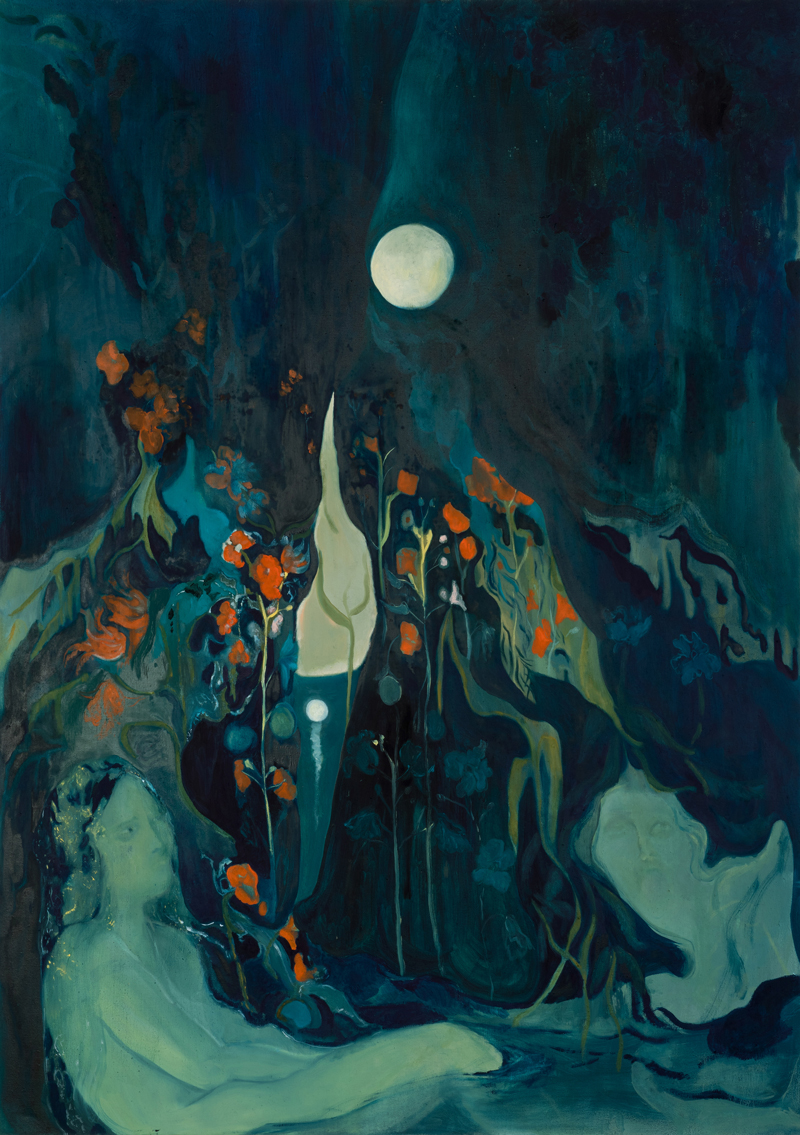
Wedding Moon, 2018,
oil on linen, 62 x 44 inches
“I think the overwhelming force of nature that humbles us and makes us pause, that creates a sense of great awe or terror is evidence that there is something that lies beyond us as humans.”
I don’t consider myself religious but do feel very spiritually connected to nature and often create rituals and celebrations around it similar to Paganism. It’s healing for me to be in nature and find the magic in it, and my hope is that by depicting that through painting, I can heal others.
I was recently reading a work by an author who takes a pretty anti-romantic stance towards nature. It’s interesting to have these two things in my head right now. Whether it's expressed through painting, or rituals, and whatnot, do you think that these forms of spirituality attempt to control or temper human nature, or the natural world?
I don't think there's any way of controlling nature. I think these forms of spirituality are a way of giving over control actually, and being okay with the unknown. I think if anything it tempers fear as it is replaced with faith.
For The Flowering Songs show [at Projet Pangée], what was the thought process behind installing the fruit and objects that accompany the paintings? What’s the conversation between them?
The Flowering Songs had several paintings of apples and apple orchards which related to the gardens from my childhood home as well as the symbolism of temptation. I wanted to have the apples in the space, which were a miniature variety the size of crabapples, in a large planter urn.
I’m very interested in curating my domestic and studio spaces and often arrange fruits and flowers and other objects. What I was trying to do in that show was to bring that into the gallery environment. I don't think I was that successful in it.
I’m very interested in curating my domestic and studio spaces and often arrange fruits and flowers and other objects. What I was trying to do in that show was to bring that into the gallery environment. I don't think I was that successful in it.
![]()
Red Moon in the Orchard, 2017,
oil on linen, 41 x 58.5 inches
The press release for that show also mentions a haunted childhood. What did that entail?
My childhood home was haunted growing up. I experienced a lot of visitors and different presences. I don't know if you've ever visited British Columbia, but there's something really special, a specific energy there, that I think is from the ocean, and how dense the landscape can be in areas. The moss drips from the trees. The fog blanks out the world and you can separate sand with magnets. It's always moving. Growing up in that landscape and in our haunted house and surrounding gardens has affected me, and I'm always going to be pulling from those memories of childhood.
When you talk about being haunted and spiritual, there is a sense of sorrow, and there's a lot of emotion there. You talk about it being scary to be vulnerable, but at the same time, there's not a sense of danger. They're very intense, but they also feel so introspective. Do you feel like you find a sense of safety there?
I do find safety there! My work is all about emotion and evoking it in others. I’m an empath and a healer and I feel lucky to have a medium for it. I'll paint when I'm really tired or really sad or feeling broken or elated and I paint the pain or the joy that I see or feel in others.
I think everybody is seeking a truth, finding themselves, or trying to find the right direction. This is a theme in my work as well, portrayed by figures traversing pathways, seeking and wandering, and even symbolically through darkness, shadow and light. There’s a drama to it that I love that reminds me of my dancing and the theatre, like the two masks of comedy and tragedy.
I think everybody is seeking a truth, finding themselves, or trying to find the right direction. This is a theme in my work as well, portrayed by figures traversing pathways, seeking and wandering, and even symbolically through darkness, shadow and light. There’s a drama to it that I love that reminds me of my dancing and the theatre, like the two masks of comedy and tragedy.
![]()
Installation view, Although the Wind, 2020,
Projet Pangée, Montreal
“I think everybody is seeking a truth, finding themselves, or trying to find the right direction.”
There's a great play in opacity in the works; colors and forms coming in and out, like a gradient. How do you know when to pull back, to stop layering or taking away? When a painting is done?
The painting tells you when it's done. Ideally I like to work very quickly to give the painting a sense of movement and effortlessness. I think a painting loses energy when it gets overly fussy. In the painting Although the Wind (2020) for example, there's something really beautiful about the spontaneity in that work. You can feel the energy of the brushstrokes up in the trees and the anxiety of the figures. I love how painterly it is – it has an unfinished quality. A painting feels finished to me when there is a sense of balance achieved with colour, light and composition.
![]()
Although the Wind, 2020,
oil on canvas, 96 x 72 inches
In your 2016 solo show, Blue Hyacinth at Erin Stump Projects in Toronto, the themes seem to be more broad or universal than what you’re working on now. Do you feel that your work has become more localized or personal?
I think the work is getting much more personal. I used to think I had to assert themes or concepts onto my work. That was my first solo show and I exhibited large scale drawings inspired by the mythological story of the Hyacinth. After that I just started painting for myself, as an outlet, as a place to remember or dream, as art therapy, and I started losing concern with the audience. I often don't really know what it is that I'm making or what the theme is and I don’t think it matters as long as I’m creating work from a sincere and personal place.
Visit Darby Milbrath’s artist page.
︎: @darbymilbrath

